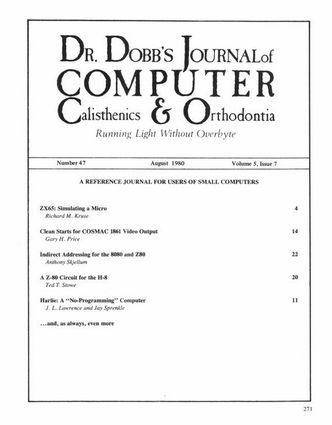
[author : Richard M. Kruse] #Listing #Assembly #Simulation
Extract : « This article gives complete details, including source code, of an assembly language program which functionally simulates the operation of a 6502 microprocessor device using a Z80 based host computer system. Under control of ZX65, a wide variety of 6502 software may be directly executed in any of several modes. Useful for 6502 software development as well as for its tutorial value, ZX65 should prove to be a significant addition to the Z80 user’s software library. Occupying only 4K Bytes of system memory, ZX65 is sufficiently flexible to be readily adapted to system environments other than the one described. [...] »
[author : J. L. Lawrence and Jay Sprenkle] #Listing #BASIC #DataManagement #ArtificialIntelligence
Extract : « It was with much interest and skepticism that the authors read the article “Build a Self-Learning No-programming Computer with your Microprocessor” by Klaus Holtz in DDJ #33. The article describes a computer which requires no programming, is educated almost like a human child, and is relatively inexpensive. Applications suggested'for this new computer include language translation, a typewriter which refuses to type incorrectly spelled words, unbreakable secret codes, and others which are currently difficult to implement. All of this is claimed to be achievable with no programming!
The article’s author describes briefly the theory behind the proposed computer as “Knowledge Processing and Infinite Dimensional Networks.” It would be nice to have a reference for such an amazing theory, if a reference does exist. Rather than repeat the theory here, we merely pause to mention it. As Holtz points out, understanding of the theory is not necessary to implement his ideas. [...] »
[author : Gary H. Price] #Listing #Assembly #Display
Extract : « [...] Thus, if the 1861 is re-enabled within the display window (as can occur with ELF II TINY BASIC), the initial series, or partial series, of DMA requests following the enable will be received during execution of code outside the display-refresh routine. Such an occurrence is accompanied by a flash of “garbage” on the display screen.
The code given in Listings 1 and 2 avoids such bad frames by assuring that the 1861 is enabled outside the display window. [...] »
[author : Dave Caulkins] #SocialNetworks
Extract : « The PCNET Project has operated a bulletin board system* in the San Francisco Bay Area for about two years. The system we’re running now is the Apple Bulletin Board System from Peripherals Unlimited. In late May/early June of ’80 our ABBS experienced a (for me) novel problem; a person or persons would call the system, give a CB-like ‘handle’ instead of a name during logon, and then leave messages making free use of all the well known anglo-saxon expletives. [...] »
[author : Charles Wetherell] #OperatingSystem #Programming
Extract : « [...] A dataflow computer has five main components: instruction memory, data memory, arbitration network, distribution network, and a battery of processors. In a conventional computer, instructions sit passively, waiting for the CPU to call them for execution. On a dataflow machine, each instruction takes an active part in the computation. An instruction waits for all of its operands to be ready; when they are, the instruction signals the arbitration network that it is ready for execution. The arbitration network packs the data and the instruction together and ships the package to a free processor. When the processor is through executing the instruction, the results are shipped back through the distribution network to any instructions waiting. In the graph above, the output from the left-hand square instruction would be passed to both the add and the subtract. [...] »
[author : Ted T. Stowe] #Electronic
Extract : « Thought you might be interested in a Z-80 circuit for the H-8 computer. I have had this circuit running for several months and have had only one minor problem, and that is that I had to go to CP/M for a Z-80 assembler as the Heath disk operating system is strictly 8080. [...] »
[author : Anthony Skjellum] #Listing #Assembly #Programming #Book
Extract : « The 8080 and Z80 microprocessors do not provide indirect addressing modes for all instructions. This article, a response to a previous one dealing with indirect CALLs for the 6502, deals with the implementation of indirect addressing in software. Three techniques are explored: the “ mini-program, ” as discussed in the 6502 article, the self-modifying subroutine and the self-modifying macro instruction. These techniques are applied to various instructions which lack the indirect mode. As well, the use of the one byte RST calls is suggested as a means of accessing the indirection routines in a fast manner. Finally, a specific example dealing with the Z80 indexed addressing mode is provided. The many listings are provided to act as a tutorial and an impetus to the reader to use the methods suggested in future software development. [...] »